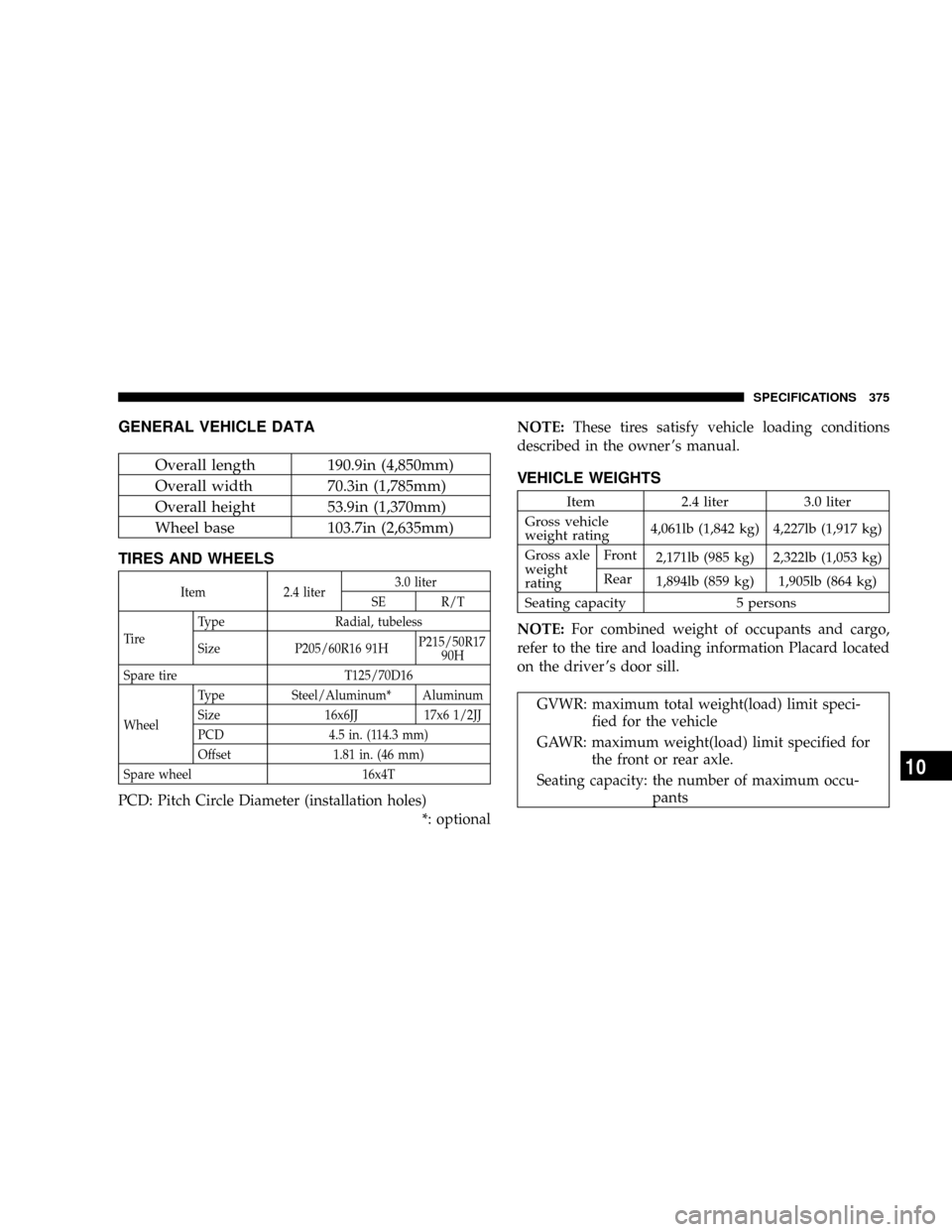2005 DODGE STRATUS COUPE weight
[x] Cancel search: weightPage 342 of 396

Tire pressure for sustained high-speed driving
For sustained high-speed driving, increase inflation pres-
sure 4 psi (28 kPa) above the recommended pressure but
do not exceed the maximum cold inflation pressure
molded into the tire sidewall.
Replacing tire and wheels
CAUTION!
²Avoid using different size tires from the one listed
and the combined use of different types of tires,
as this can affect driving safety.
Refer to the(TIRES AND WHEELS(on page 377.
²Even if a wheel has the same rim size and offset as
the specified type of wheel, its shape may prevent
it from being fitted correctly. Consult an autho-
rized dealer before using wheels that you have.
Tire maintenance
The following maintenance steps are recommended:
1. Check pressure regularly.
2. Maintain wheel balance and front suspension align-
ment.3. Rotate tires regularly in accordance with the recom-
mendation in the section ªTire rotationº on page 347.
Loading information
WARNING!
Overloading of your tire is dangerous. Overloading can
cause tire failure, affect vehicle handling, and increase
your stopping distance. Use tires of the recommended
load capacity for your vehicle. Never overload them.
It is important to familiarize yourself with the following
terms before loading your vehicle:
²Vehicle maximum load on the tire : load on an indi-
vidual tire that is determined by distributing to each
axle its share of the maximum loaded vehicle weight
and dividing by two.
342 MAINTENANCE
Page 343 of 396

²Vehicle normal load on the tire : load on an individual
tire that is determined by distributing to each axle its
share of the curb weight, accessory weight, and nor-
mal occupant weight and dividing by two.
²Maximum loaded vehicle weight : the sum of ±
(a) Curb weight;
(b) Accessory weight:
(c) Vehicle capacity weight; and
(d) Production options weight.
²Curb weight : the weight of a motor vehicle with
standard equipment including the maximum capacity
of fuel, oil, and coolant, and, if so equipped, air
conditioning and additional weight optional engine.
²Accessory weight : the combined weight (in excess of
those standard items which may be replaced) of auto-
matic transmission, power steering, power brakes,
power windows, power seats, radio, and heater, to the
extent that these items are available as factory-
installed equipment (whether installed or not).
²Vehicle capacity weight : the rated cargo and luggage
load plus 150 lbs (68kg) times the vehicle's designated
seating capacity.
²Production options weight : the combined weight of
those installed regular production options weighing
over 5 lbs (2.3kg) in excess of those standard items
which they replace, not previously considered in curb
weight or accessory weight, including heavy duty
brakes, ride levelers, roof rack, heavy duty battery, and
special trim.
²Normal occupant weight : 150 lbs (68kg) times the
number of specified occupants. (In your vehicle the
number is 3).
²Occupant distribution : distribution of occupants in a
vehicle as specified. (In your vehicle the distribution is
2 in front, 1 in second seat).
Steps for Determining Correct Load Limit
1. Locate the statement9The combined weight of occu-
pants and cargo should never exceed XXX pounds9on
your vehicle's placard.
MAINTENANCE 343
9
Page 344 of 396

2. Determine the combined weight of the driver and
passengers that will be riding in your vehicle.
3. Subtract the combined weight of the driver and pas-
sengers from XXX kilograms or XXX pounds.
4. The resulting figure equals the available amount of
cargo and luggage load capacity. For example, if the
9XXX9amount equals 1400 lbs. and there will be five 150
lb. passengers in your vehicle, the amount of available
cargo and luggage load capacity is 650 lbs. (1400-750 (5 x
150) = 650 lbs.)
5. Determine the combined weight of luggage and cargo
being loaded on the vehicle. That weight may not safely
exceed the available cargo and luggage load capacity
calculated in Step 4.
6. If your vehicle will be towing a trailer, load from your
trailer will be transferred to your vehicle. Consult this
manual to determine how this reduces the available
cargo and luggage load capacity of your vehicle.
NOTE: The above steps for determining correct load
limit were written in accordance with U.S.A. regulations.
Your vehicle cannot tow a trailer, so step 6 is irrelevant.
NOTE:
(1) The following table shows examples on how to
calculate total cargo/load capacity of your vehicle with
varying seating configurations and number and size of
occupants. This table is for illustration purposes only and
may not be accurate for the seating and load capacity of
your vehicle.
(2) For the following example the combined weight of
occupants and cargo should never exceed 865 lbs.
(392kg).
(3) Under a maximum loaded vehicle condition, gross
axle weight ratings (GAWR's) for the front and rear axles
must not be exceeded. For further information on
GAWR's, vehicle loading and trailer towing, see the
9Specifications9section of this manual.
344 MAINTENANCE
Page 346 of 396

Cargo loads
The load-carrying capacity of your vehicle is shown on
the tire and loading information placard.
DO NOT USE the weight rating data provided on the
safety certification label for determining vehicle passen-
ger and/or cargo load capacity.
For determining the combined weight of occupants and
cargo, use the specifications provided on the tire and
loading information placard.
Tread wear indicators
Tread wear indicators are built into the original equip-
ment tires on your vehicle to assist you in determining
when your tires have been worn to the point of needing
replacement. Many states have laws making tire replace-
ment mandatory at this point.
These indicators are molded into the bottom of the tread
grooves and will appear as 1/2 in (13 mm) wide bands
when tire tread depth becomes 1/16 in (1.6 mm).
M32A0010
Location of tread wear indicator
Tread wear indicator
346 MAINTENANCE
Page 371 of 396

SPECIFICATIONS
CONTENTS
mVehicle labeling........................372
N1 - Vehicle emission control information label . . 372
N2 - Vehicle identification number plate.......372
N3 - Vehicle information code plate..........372
N4 - Air conditioner label.................372
N5 - Engine serial number.................373
N6 - Tire and loading information placard.....374N7 - Certification label...................374
mBattery..............................374
mGeneral vehicle data....................375
mTires and wheels.......................375
mVehicle weights........................375
mEngine specifications....................377
mCapacities............................378
10
Page 375 of 396

GENERAL VEHICLE DATA
Overall length 190.9in (4,850mm)
Overall width 70.3in (1,785mm)
Overall height 53.9in (1,370mm)
Wheel base 103.7in (2,635mm)
TIRES AND WHEELS
Item 2.4 liter3.0 liter
SE R/T
Ti reType Radial, tubeless
Size P205/60R16 91HP215/50R17
90H
Spare tire T125/70D16
WheelType Steel/Aluminum* Aluminum
Size 16x6JJ 17x6 1/2JJ
PCD 4.5 in. (114.3 mm)
Offset 1.81 in. (46 mm)
Spare wheel 16x4T
PCD: Pitch Circle Diameter (installation holes)
*: optionalNOTE:These tires satisfy vehicle loading conditions
described in the owner 's manual.
VEHICLE WEIGHTS
Item 2.4 liter 3.0 liter
Gross vehicle
weight rating4,061lb (1,842 kg) 4,227lb (1,917 kg)
Gross axle
weight
ratingFront
2,171lb (985 kg) 2,322lb (1,053 kg)
Rear
1,894lb (859 kg) 1,905lb (864 kg)
Seating capacity 5 persons
NOTE:For combined weight of occupants and cargo,
refer to the tire and loading information Placard located
on the driver 's door sill.
GVWR: maximum total weight(load) limit speci-
fied for the vehicle
GAWR: maximum weight(load) limit specified for
the front or rear axle.
Seating capacity: the number of maximum occu-
pants
SPECIFICATIONS 375
10
Page 376 of 396

Cargo loads capacity: 150 lbs (68kg) time the des-
ignated seating capacity,
subtract from the vehicle
capacity weight.CAUTION!
Do not use the gross vehicle weight rating data
provided in the chart or on the safety certification
label for determining vehicle passenger and/or cargo
load capacity.
Use the values provided on the tire and loading
information placard (Refer to the section ªVehicle
labelingº).
376 SPECIFICATIONS
Page 396 of 396

Tire chains.......................... 348
Tread wear indicators.................. 346
Tools................................ 266
Towing.............................. 284
Trailering........................... 205
Trailer Towing......................... 205
Transaxle
Automatic transaxle................... 155
Autostick........................... 165
Manual transaxle..................... 168
Transmission
Automatic transmission................ 160
Transmitter, Garage Door Opener........... 134
Transporting Pets....................... 103
Trip odometer......................... 108
Trip odometer reset button................ 108
Trunklid .............................. 35
Turbocharger boost gauge................ 108
Turn signal indicators.................109,114
Lever.............................. 124
Uniform Tire Quality Grades.............. 387
Universal Transmitter.................... 134Vanity mirror.......................... 211
Vehicle Identification Number............... 5
Vehicle labeling........................ 372
Vehicle Weights........................ 375
Ventilators............................ 237
Warnings and Cautions.................... 5
Warranty Information.................... 382
Washer fluid level indicator............... 109
Washer
Windshield.......................130,333
Washing.............................. 255
Waxing.............................. 257
Wheel covers.......................... 268
Whip antenna......................... 221
Windshield washers..................130,333
Windshield wiper blades................. 333
Windshield wipers...................... 128
396 INDEX